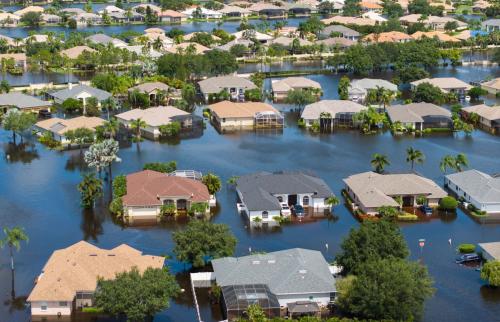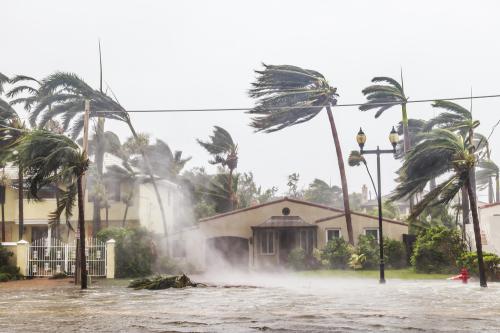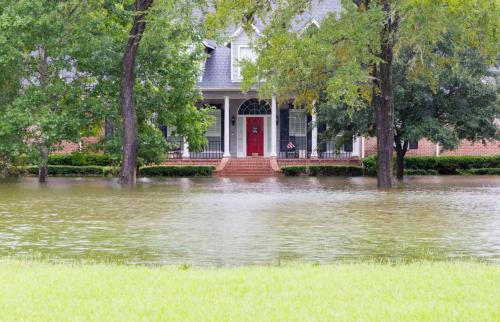The increasing frequency and severity of extreme weather events and the rising cost of homeowners insurance has led some states to offer grants or loans to homeowners to strengthen their roofs or otherwise make their homes more resilient.
Here is what several states are currently doing. Many of the following programs fund home retrofitting contingent on new or strengthened roofs meeting the FORTIFIED HomeTM standard from the Insurance Institute for Business and Home Safety (IBHS), an industry group. This designation is given to homes using construction methods and materials that meet minimum performance standards during a major storm. These range from improved roofing nails to engineered roof attachment systems that anchor a roof to a home’s framing and foundation.
Wind and hurricane
Alabama
Strengthen Alabama Homes (SAH), created in 2011 and first funded in 2015, offers grants to harden roofs. Grants pay 100% of retrofit costs up to $10,000. Applicants must first pay for an evaluation of their roofs, after which they may apply for state grants. For a grant recipient to receive funds, work must be completed and then assessed by a certified evaluator. Funds are provided by the insurance industry in Alabama, not state or federal sources. Recipients must have an in-force homeowners insurance policy (including coverage for wind damage) and flood insurance if they’re in a flood zone. Since 2016, SAH has issued over $86 million in grants to fortify more than 8,700 homes. The state of Alabama also offers a separate tax credit of up to $3,000 in the year of grant reception.
SAH funds home retrofitting according to the FORTIFIED Home standard. A May 2025 study from the Alabama Department of Insurance and the University of Alabama’s Center for Risk and Insurance Research examined the effects of Hurricane Sally, a Category 2 storm that made landfall in September 2020, on homes with unfortified roofs and those with roofs that met IBHS-certification, many of which had been funded by SAH. The study estimated that total damage would have been around 75% less if every home were built to a FORTIFIED standard. Actual damage severity for insurance claims on retrofitted homes measured 20% to 40% lower than comparable real estate.
Another analysis by the University of Alabama center, using data from 2004 to 2016, found that homes built or retrofitted to a FORTIFIED standard in Baldwin or Mobile counties raised the resale price of a home by almost 7%, after controlling for other housing and locational characteristics. “The additional cost of building or retrofitting is frequently less than 7% of home value; therefore, the benefit of a FORTIFIED designation is very likely to outweigh costs,” the report said.
Florida
After a destructive 2004-2005 hurricane season, Florida launched My Safe Florida Home in 2006. Owners of single-family homes can request a free wind-mitigation inspection, and those whose homes are valued at less than $700,000 may apply for a grant to upgrade their roofs. Homeowners pay two-thirds of the cost, and the state pays the rest—up to $10,000. The matching requirement is waived for low-income households.
Between July 2007 and January 2009, the state received over 420,000 applications, performed over 390,000 inspections, and awarded just under 39,000 grants—together totaling about $152 million. In May 2009, a study commissioned by the state found that if all homes in the state were to invest in damage mitigation—including roof reinforcement—damages would be 55% less after a major storm. After only a few years, the study found, every dollar spent on mitigation through the My Safe Florida Home program translated to a $1.50 decrease in damage loss.
Funding lapsed after 2009, however, and wasn’t revived by the legislature until 2022, when it was allocated $150 million. In 2023, the legislature allocated $100 million plus an additional $181 million in a special session. $100 million was allocated in 2024.
In 2022 and 2023, more than 90,000 inspections were completed, and more than 21,000 grants were awarded. By November 2023, $36 million had been disbursed and another $181 million obligated from the announced $250 million. The additional funding from the special session was reported to be enough to fund the backlog of grant recipients whose grants had not yet been allocated funding. As of March 2025, over 30,000 properties in the state had been inspected without the homeowner moving forward in the retrofit process. In 2025, the legislature appropriated another $280 million for the program—less than half of the governor’s request—after legislators cited statistics showing that more than 7,000 applicants with approved grants let their award expire unused.
Louisiana
In 2022, Louisiana created the Fortify Homes Program after about a dozen insurers writing policies in the state went bankrupt and more stopped adding new customers.. Homeowners may receive up to $10,000 from the state to retrofit their roofs to a FORTIFIED standard. Homes in coastal counties are eligible and those who receive grants are chosen by lottery from the applicant pool. The program started in 2023 with $30 million. Lawmakers allocated $15 million more in 2024 but have not allocated to the program since. The program has served 10,000 homes, the state says. In November 2025, the state opened the lottery for another 1,000 homes.
North Carolina
North Carolina offers two mitigation programs based on geography. The Strengthen Your Roof program provides grants of up to $10,000 to homeowners in beach communities, while the Strengthen Your Coastal Roof program pays up to $6,000 for other areas further from the ocean but near the intracoastal waterway. Both programs in North Carolina use the IBHS FORTIFIED standard for certifying mitigating retrofits.
Both programs are funded by the North Carolina Insurance Underwriting Association, a non-profit organization of insurance companies created by law to act as a market of last resort providing essential property insurance in beach and coastal areas of the state.
As of October 31, 2025, the two grant programs had completed more than 10,300 roof projects and had more than 3,600 in progress, according to the North Carolina Joint Underwriting Association. A study from the North Carolina State University’s Institute for Advanced Analytics found “homes with a FORTIFIED roof had about 35% fewer claims after Hurricanes Matthew, Florence, Dorian, and Isaias. When claims were filed, the damage was about 23% less severe.” Another Institute study found that there were 63% fewer claims on insurance policies after unnamed storms between 2018 and 2024 on certified roofs than similar unreinforced roofs.
South Carolina
South Carolina created the SC Safe Home Mitigation Grant Program in 2007. The program utilizes tiers of upgrades and grant matching based on household income. State payouts range from $3,000 at the lowest tier, for both non-matching and matching grants, to $7,500 for non-matching grants at the highest mitigation tier. The matching amount depends on the homeowner’s income relative to the median income for the county in which they reside. Funds are available only for retrofitting owner-occupied, single-family homes.
As of January 2025, according to the South Carolina Department of Insurance’s 2024 status report on the coastal property insurance market, 7,992 homeowners had received $39 million in grants since the program’s inception. The report said that homeowners reported savings of up to 24% on annual property insurance premiums after retrofitting their home with the SC Safe Home program.
Oklahoma
The Strengthen Oklahoma Homes Program, launched in 2025, provides up to $10,000 in particularly vulnerable communities to reinforce roofs against storm, wind, and hail damage. The state uses the IBHS FORTIFIED standard, but homeowners must complete retrofit work with an additional “Hail Supplement” to qualify for a grant. Homes must also have an in-force homeowner’s insurance policy with wind damage coverage as well as flood coverage depending on location. Applications opened in March 2025 for selected zip codes; the program is projected to be available statewide in 2026. The program is currently funded by the insurance industry in Oklahoma with funding capped at $10 million per year. The state began its third and final pilot phase of the program in November 2025 and has completed over 100 retrofits with hundreds more in progress. State officials hope to have 1,000 projects completed by the end of fiscal year 2026.
Wildfire
California
California’s Wildfire Mitigation Program provides financial assistance to California residents to harden homes against wildfire risk. The program was created in 2019 and is managed jointly by the state’s Office of Emergency Services and California Department of Forestry and Fire Protection. Grants help cover costs for activities such as replacing roofs, eaves, rain gutters, siding, windows, and attic vents with fire-rated materials. Requirements for participation in the program include the creation of defensible space around a home before any retrofit—removing vegetation, combustible ground cover materials, and trees or tree branches within various distances of structures. Homes must also be owner-occupied.
The program is still in a pilot phase, with funding and retrofits underway in the six most fire-vulnerable counties in California. The program scores counties for both physical risk and social vulnerability factors. Physical risk includes the number of land tracts in high-risk fire zones and fire hazard probability. Social vulnerability includes factors such as number of seniors over 65, residents in poverty or without a car, and residents with a disability.
As of October 2025, total funding allocated for the program was over $117 million, with the federal government paying more than $95 million of that, the state paying almost $21 million, and homeowners paying the rest. Across six counties, 76 retrofits have been completed; 46 more are in progress.
Flood
New York
New York’s affordable housing agency, New York State Homes and Community Renewal, offers a mixed loan/grant program to help homeowners retrofit homes against flood damage. The Resilient Retrofits program offers up to $50,000 split equally between a grant amount and a low-interest loan. Only residents with income below 120% of their area’s median income are eligible.
Eligible use cases for award money are wide-ranging, including the elevation of electrical and HVAC systems above possible high-water lines, installation of flood vents and backflow preventers, and installation of storm-rated windows and shutters. Other improvements covered include energy efficiency upgrades such as insulation materials, duct and gap sealing, and replacement of appliances with non-fossil fuel alternatives.
The program’s pilot stage was allocated $10 million. In November 2024, New York Governor Kathy Hochul announced a second round of funding allocating $20 million to the program. As of November 2025, just over 200 homeowner applications had been approved; 60 homes have been retrofitted since the inception of the pilot program in 2023.
The Brookings Institution is committed to quality, independence, and impact.
We are supported by a diverse array of funders. In line with our values and policies, each Brookings publication represents the sole views of its author(s).









Commentary
What incentives are states offering to make houses less vulnerable to extreme weather damage?
November 21, 2025